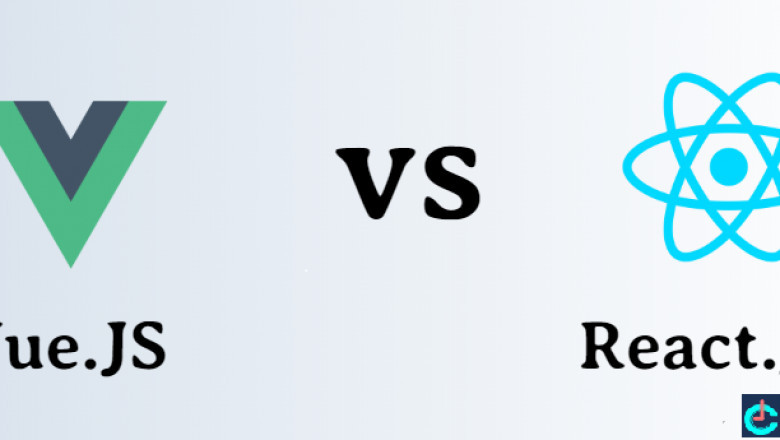views

React or Vue.js:Which JavaScript framework should you use:? The new WordPress editor is powered on React, while Vue.js is a popular framework in the Laravel community.
The two most popular frontend JavaScript frameworks in the developer world are React.js and Vue.js. React is a declarative programming language that interacts with HTML documents via a virtual DOM.
Both React and Vue provide software developers with a practical way to develop a wide range of online applications, but each has its own set of best practices and caters to distinct business demands.
What is Vue.js ?
Vue.js is an open-source JavaScript front-end framework. Single-page apps and user interfaces are built using its model-view-view-model architecture.
Evan You created it, and it uses 'high decoupling,' which allows Vue developers to gradually create user interfaces.
Vue.js is a sophisticated framework for creating user interfaces.
Vue JavaScript, unlike the other monolithic frameworks, is built from the ground up to be progressively adopted.
The Vue framework's primary library is focused solely on the view layer and is simple to learn and integrate with a variety of libraries and existing projects.
When used in conjunction with supporting libraries and modern tooling, Vue js is also quite capable of powering elegant single-page applications.
Features of Vue.js
Components
Vue.js Components are one of the framework's most essential features. They're used to encapsulate reusable code and augment basic HTML components. In Vue.js applications, you may construct reusable custom elements that can then be reused in HTML.
Templates
Vue.js comes with HTML-based templates for binding the displayed DOM to the Vue instance data. All Vue templates are valid HTML that can be processed by browsers and HTML parsers that follow the specification. The templates are compiled into Virtual DOM render methods by Vue.js. Before refreshing the browser, Vue renders components in virtual DOM memory. When you alter the state of an application, Vue can determine the smallest number of components to re-render and the smallest amount of DOM operations.
Reactivity
Vue features a reactivity framework that optimizes re-rendering by using simple JavaScript objects. Each component keeps track of its reactive dependencies during this process, so the system knows exactly when and which components to re-render.
Routing
The official Router is used by Vue to route users through URLs.
The inability of single-page applications (SPAs) to partition connections to specific subpages inside a single web page is the most common flaw.
Because SPA only provides users with a single URL-oriented response from the server, bookmarking particular screens or allocating links to specific areas is difficult, if not impossible.
To solve this problem, several client-side routers use a 'hashbang' (#!) to limit the dynamic URL.
When things are updated, inserted, or removed from the DOM, Vue provides a variety of techniques to apply transition effects. This includes tools for:
-
Use JavaScript to alter the DOM right immediately during the transition hooks.
-
Assimilate the Velocity.js third-party JavaScript animation library.
-
Apply the CSS animations and transitions classes mechanically.
-
Animate.css, a third-party CSS animation library, should be used.
What is React?
React is a JavaScript library that may be used to create web application interfaces. By reusing components, React or rather ReactJS aids in the development of a better framework for its products. ReactJS is made up of two parts: HTML code and HTML document. HTML code is used to create the user view layer, also known as the User Interface (UI). All of the components are contained on the HTML page.
React was built by Jordan Walke, a Facebook software engineer. In the year 2011, React was created. React, on the other hand, was designed with Facebook in mind. The React library comes in handy for creating websites and apps. Whatsapp and Instagram are two of the most well-known companies that have embraced React. As a result, React was released to the general public in 2013.
Features of React
Simple
React is considerably simpler to understand and put into effect. As a result, any developer who has worked with JavaScript can rapidly pick up React and start developing web applications.
Reusable elements
Reusability of code is one of the most important features of React. Developers' workload is made easier by reusability. Programmers do not need to build separate scripts for related app components. As a result, the code can be reused. As a result, code reusability aids in the reduction of manufacturing costs.
Easy Code Testing
Testing is another important aspect of React. It comes with native tools that make testing and debugging a breeze. The component-based architecture of ReactJS decreases the amount of debugging required. Changes to one component of the app have no effect on the others. As a result, React saves a significant amount of time when it comes to testing and troubleshooting.
SEO Friendly
The use of ReactJS speeds up the creation of web pages. React applications load pages much faster than other types of applications. As a result, React pages have a low bounce rate. Furthermore, React's components, such as React Helmet and React Router, aid in the development of SEO-friendly applications.
Vue vs React
Wrapping Up
Both React and Vue are excellent technologies for creating interactive user interfaces. You must consider various variables when deciding which one is best for your project, including your company needs, specific use case, developer availability, environment, timescale, and budget.
If you're still not convinced, enlist the assistance of the top react agency.
Vue.js appears to be adopting many of the concepts introduced in React and polishing and improving them. Some argue that Vue.js offers a more manageable learning curve. It appears to be highly popular in the Laravel community, and I believe Vue 3's release will be a significant event for Vue.js aficionados. Vue.js, in my opinion, has a robust community, however it is not on par with React.












